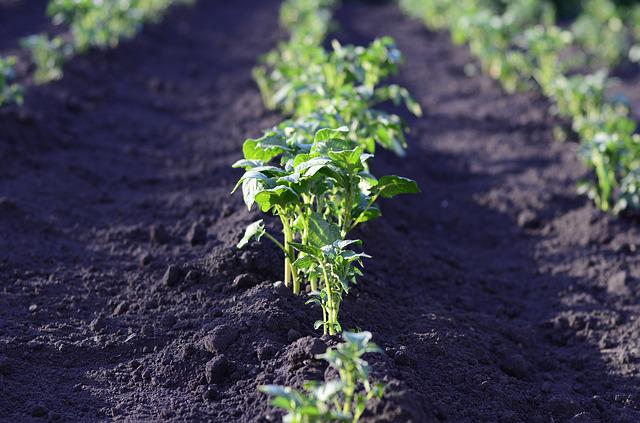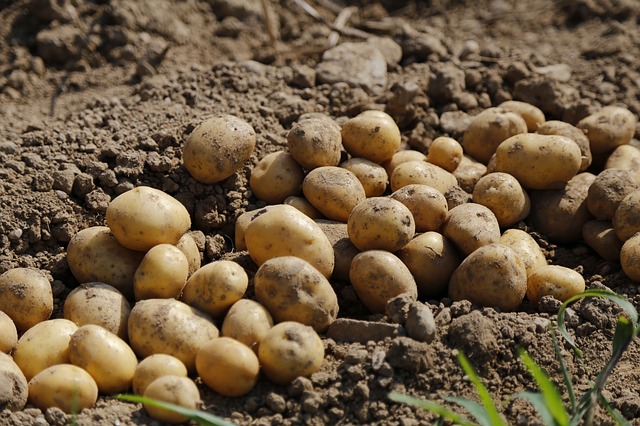Potatoes are one of the most popular vegetables in the world. They are a good source of vitamins and minerals and can be prepared in various ways. Potatoes can be boiled, baked, mashed, or fried, often used as a side dish or as an ingredient in other dishes. Growing potatoes is relatively easy, and they can be harvested in a short amount of time. So, how deep do you plant potatoes? I will discuss it more later.
There are many different types of potatoes, each with its unique flavor and texture. The most common type of potato is the russet potato, which is often used for baking or frying. Other popular potatoes include Yukon Gold, red, and new potatoes.
When selecting potatoes, look for firm ones with few blemishes. Avoid potatoes that are sprouting or have greenish-brown spots. Potatoes should be stored in a cool, dark place and will keep for up to two weeks.
How Deep Do You Plant Potatoes?
This is a common question among gardeners, as potatoes are a popular vegetable to grow at home. The answer depends on a few factors, such as the type of potato and the climate in which it is being grown. For example, in warmer climates, you can plant potatoes shallower than in cooler climates.

When planting potatoes, place the tubers about 8-10 inches deep in the soil. They should be about 12 inches apart, and rows should be about 3 feet apart. If you are growing more than one variety of potatoes, it is best to plant them in separate areas of the garden. This will help prevent cross-pollination and allow you to harvest the potatoes at different times.
Once the potatoes have been planted, you must water them regularly. Water them deeply so that the water reaches the roots. Potatoes will also need to be fertilized every few weeks. Use a balanced fertilizer, such as 10-10-10, and apply it according to the manufacturer’s instructions.
As the potatoes grow, you may need to hill them up. This means that you will need to mound soil around the plants. This will help to prevent the tubers from being exposed to sunlight, which can cause them to turn green and taste bitter.
Potatoes are usually ready to harvest about 2-3 months after they are planted. To check if they are ready, dig up one or two plants and see if the tubers are the desired size. If they are not yet ready, replant them and check again in a few weeks.
Once the potatoes have been harvested, they can be stored in a cool, dark place for up to two months. If you want them to last longer, you can store them in a root cellar or refrigerator.
In general, it is recommended to plant potatoes about eight inches deep. This will help the potato plants to develop a strong root system, which is necessary for producing a good yield. Additionally, planting deeper helps to protect the potato tubers from being damaged by frost or cold temperatures. Your potato plants will thrive and produce a bountiful harvest with proper care.
Which Month Do You Plant Potatoes?
You can plant potatoes from late March to early May, as long as the ground isn’t frozen and the soil temperature is above 10 degrees centigrade. However, late April/ early May is usually the best time to plant them. This is because they’ll be less likely to be affected by frost, and you’ll be able to harvest them earlier in the year.
You can even plant potatoes in containers on your patio or balcony if you don’t have a garden. Make sure the pot is big enough for the roots to spread out and has drainage holes so that excess water can drain away. Planting potatoes is a relatively easy process. First, you must choose a sunny spot in your garden with well-drained soil. Then, dig a trench about 15cm deep and 30cm wide.
Next, add some compost or well-rotted manure to the trench and mix it with the soil. Finally, place your potato plants in the trench, keeping them about 30cm apart. Once they’re in place, cover them over with soil and water them well. Then all you need to do is wait for them to grow!
Do You Need To Cut Seed Potatoes Before Planting?
This is a common question among gardeners, and there is no easy answer. Some experts recommend cutting the potatoes into small pieces before planting, while others say this isn’t necessary. There are a few factors to consider when making your decision. First, think about the size of your potato.
If it is large, cutting it into smaller pieces will help it to grow more evenly. Second, consider the climate in which you are planting. If the weather is warm, your potato will sprout more quickly and may not need to be cut.
Finally, think about the type of potato you are planting. Some varieties are more likely to produce multiple offsets, or “eyes,” and may benefit from being cut into smaller pieces. Ultimately, the best way to determine whether or not to cut your seed potatoes is to experiment and see what works best in your garden.

How Do You Protect Potatoes From Pests And Diseases?
The potato is a hardy plant that can withstand many pests and diseases; however, some can cause serious problems. Here are some tips on protecting your potatoes from the most common pests and diseases.
One of the most common pests that attack potatoes is the Colorado Potato Beetle. These Beetles can strip a plant of its leaves in a matter of days, causing serious damage. The best way to protect your potatoes from Colorado Potato Beetles is to watch them and handpick them off the plants as soon as you see them.
Another common pest is the potato bug or Wireworm. These grubs feed on the roots of potatoes and can cause serious damage to the plants. The best way to protect your potatoes from wireworms is to rotate your crops yearly and to till the soil deeply before planting.
Potatoes are also susceptible to several diseases, the most common of which is early blight. Early blight is caused by a fungus that attacks the leaves of potato plants, causing them to turn brown and wither. The best way to protect your potatoes from early blight is to water them at the base of the plant rather than above. This will help to prevent the fungus from spreading.
With a little care and attention, your potato plants should be able to withstand most pests and diseases. However, if you notice any problems, you must act quickly to minimize the damage.
Wrapping Up
Potatoes are a versatile and delicious addition to any garden. By following these simple tips, you can successfully grow potatoes in your backyard. With a little care and attention, you’ll be able to enjoy fresh, homegrown potatoes all season long! I hope this has helped you learn more about how to grow potatoes. Thanks for reading!
